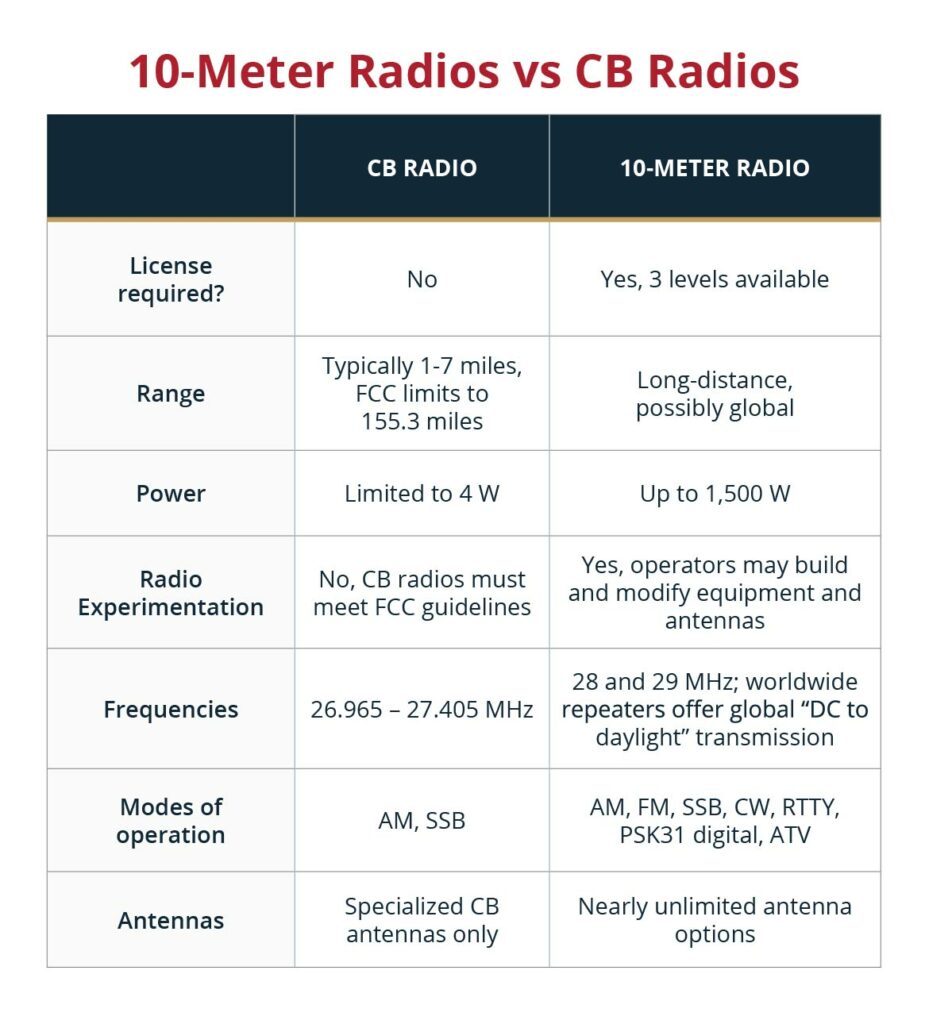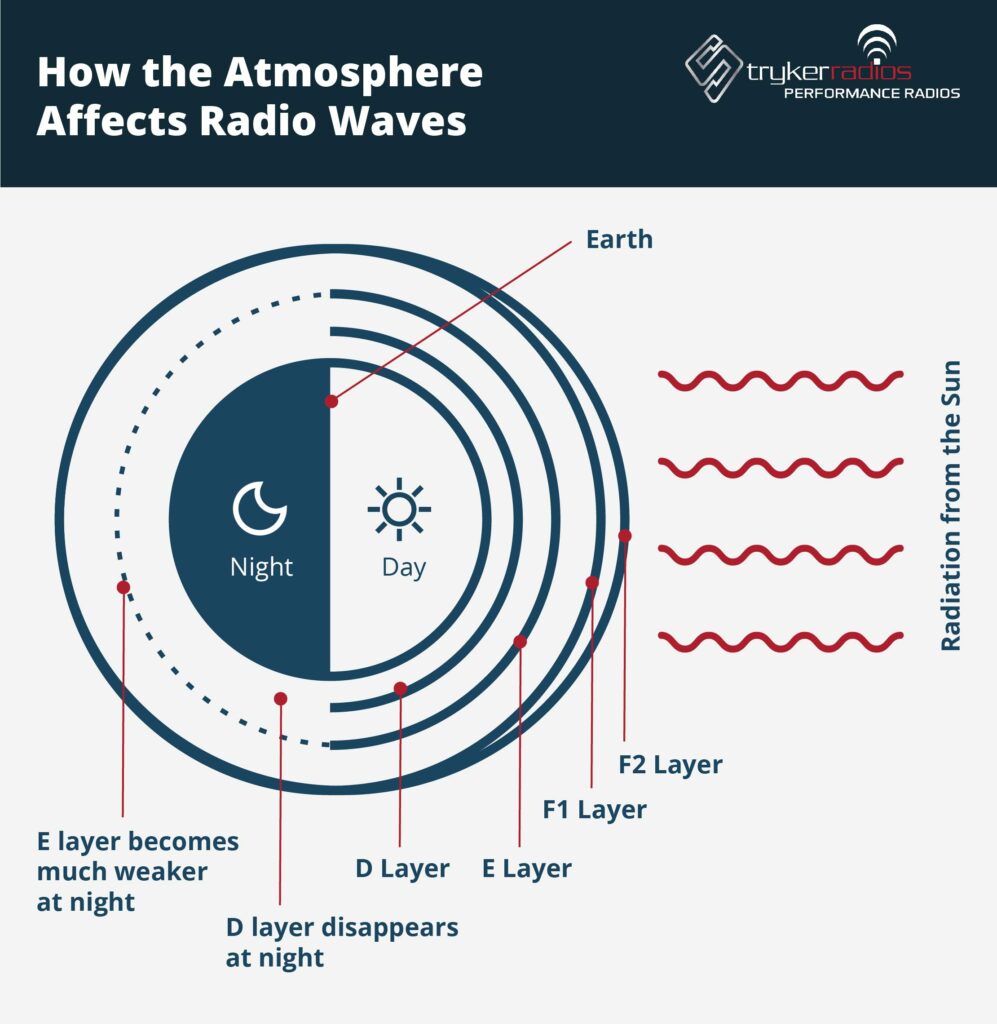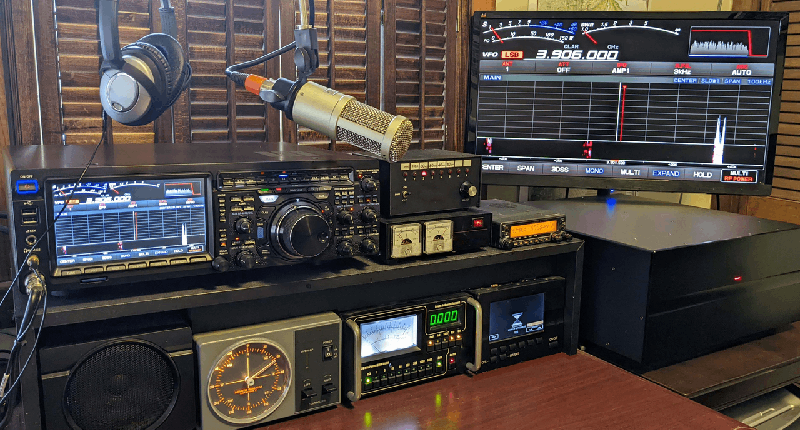Anyone who has enjoyed working with amateur radio in the last hundred years will be familiar with the 10-meter band. Globally, 10-meter radio has played a pivotal role in amateur communications, emergency coordination, and even wartime reporting. This section of the radio spectrum, from 28 MHz to 29.7 MHz, was set aside for shortwave radio from the very beginning of global radio spectrum allotment. Not only has it never fallen out of common use, quite the opposite has happened. Ten-meter radios are more popular now than ever before.
History of the 10-Meter Band
The International Radiotelegraph Conference (IRC) was the world’s original governing body that decided how to divide the radio spectrum. They became the International Telecommunication Union, which is part of the United Nations today. In the early 1900s the original IRC recognized that not only was there great interest in amateur radio, but it was amateurs who were actually driving the state of the art.
Bands were set aside at 10 meters as well as other points on the spectrum for amateur use. The 10-meter band is in the HF (High Frequency) band of the radio spectrum. VHF (Very High Frequency) begins just above the 10-meter band. UHF, or Ultra High Frequency, starts at 300 MHz. There are also separate amateur bands in both the VHF and UHF ranges. The 10-meter band originally ran from 28 MHz to 30 MHz, but it was pared back in 1947. However, the value of amateur radio users has never been questioned.
Because they have a high power output, 10-meter radios are strictly regulated by the FCC. Amateur radio operators must have a call sign that identifies who they are, and pass a test to get their amateur radio license. There are three levels of licensing, each offering expanded user privileges:
- Technician Class: entry-level license that grants transmitting privileges on the VHF and UHF bands used for local communication, and limited Ham bands for global transmissions
- General Class: expands transmitting privileges to long-distance, international communication via signal propagation, and increased voice operation on Ham bands
- Extra Class: provides access to the full range of Ham bands allocated to the Amateur Radio Service
Users must take a new test to obtain the license for each level.
The Role of CB Radios in the 10-Meter Band
CB radios came on the scene in the 1940s to provide ordinary Americans with radio communications while traveling the nation’s new interstate highway system. Their low power and higher frequencies meant they weren’t as versatile as 10-meter ham radios, but they filled a niche.
In the 1970s gas embargos became commonplace, and motorists began having problems finding gas. Fuel shortages coupled with a national speed limit of 55 mph meant there were a lot of frustrated drivers on the road. CB radios gave drivers a way to watch for speed traps and call ahead to find out which gas stations had gas. CB radio sales went through the roof. The federal government was flooded with complaints of overcrowding on the CB frequencies, so they expanded the frequency allotment to 40 channels instead of the original 23 channels.
 By the 1980s, the FCC only allowed the newer 40-channel radios to be sold, creating a glut of old radios. Many of these could be repurposed for use in the 10-meter band. It was perfectly legal for a licensed amateur radio operator to make cheap modifications and use an old CB radio in the 10-meter band. It’s still legal today, but the price of the necessary components has made it too expensive. New 10-meter radios are cheaper and considerably better than modified 40-year-old CBs.
By the 1980s, the FCC only allowed the newer 40-channel radios to be sold, creating a glut of old radios. Many of these could be repurposed for use in the 10-meter band. It was perfectly legal for a licensed amateur radio operator to make cheap modifications and use an old CB radio in the 10-meter band. It’s still legal today, but the price of the necessary components has made it too expensive. New 10-meter radios are cheaper and considerably better than modified 40-year-old CBs.
The Modern 10-Meter Band
For years, those modified CB radios created problems in the 10-meter band. Voice channels had been designated at certain points in the top end of the band. However, the re-crystalled CBs put voice channels in between the existing ham channels. The result was a confusing mess. Thankfully, those old CBs are gone now.
The FCC removed the Morse Code test requirement and Novice Class license from ham radio in 2007, clearing the way for thousands of new Technician Class operators and increasing 10-meter radio sales. It’s estimated some 700,000 new Technician Class licenses were issued as a result. Today the 10-meter band is busy, and it’s one of the few radio niches where women are as well represented as men.
How the 10-Meter Band is Divided
While the ITU agreements set aside 28 MHz to 29 MHz around the world for an amateur radio band, each nation determines its own band plan specifying how the entire range is allotted in that country. Most countries and regions have rather complex band plans. Canada has perhaps the most complex frequency allocation map, but they are actually governed under the IARU Region 2, so the map published by the Canadian government is more suggestion than law. The plan used in the US is quite simple by comparison:
- At the bottom of the band, from 28.0 MHz to 28.3 MHz, communication is limited to Continuous Wave, or Morse Code. Continuous Wave requires a very narrow bandwidth at 150 Hz, so this section provides ample space for Morse Code communications.
- Amateur radio operators with Novice or Technician licenses can use the frequency range from 28.3 MHz to 28.5 MHz for Phone (voice) communications. This 200 kHz segment is not available for transmitting digital or video; it is strictly for voice. This segment can also be used for Morse Code.
- Amateur operators with General, Advanced, or Extra radio licenses can use the entire remainder of the 10-meter band, from 28.3 MHz to 29.7 MHz for Morse Code, Phone, or Image transmission. This sizable carveout provides more experienced and committed operators a bandwidth where they’re unlikely to be interrupted by newly-licensed operators. (Novices and Technician license holders are still learning how to understand the normal QSO (conversation), and be considerate ham radio operators.)
Novice or Technician license holders who want to use a phone rather than Morse Code are restricted to Single Sideband (SSB) radio in the 10-meter band. The SSB signal uses far less of the available spectrum, so it allows space for more users. There are two SSB modes: upper sideband (USB) and lower sideband (LSB). USB is used for transmitting at frequencies above 10 MHz, so it’s the mode used for phone calls in the 10-meter band.
By its nature, SSB is simplex communication, meaning only one person can speak at a time. With modern radio transceivers, however, operators can set separate send and receive frequencies. This allows two simplex SSB channels to be used at once, so both parties can speak at the same time.
Operators with higher-level licenses can use other phone technologies throughout the upper 10-meter band, including AM, FM, and SSB. The band is not specifically AM or FM; within certain limits, the operators decide the technology to use.
Higher-licensed operators can also communicate via keyboard chat. This very popular system is known as PSK-31. It has the narrowest bandwidth of all communication methods, so twenty PSK-31 chats can be carried out in the same space as one SSB voice call. Using PSK-31 requires connecting your radio to a computer.
Propagation Characteristics
Part of the fun of the 10-meter band is learning how your transmission and reception work together with space, the atmosphere, and the terrain where you live. This band has shorter wavelengths than CB radios, but while CBs are restricted to 4 watts, ham operators can utilize up to 200 watts pep (Peak Envelope Power). 10-meter radio waves do interesting things, and learning how they work is a challenge.
These radio signals not only bounce off of hills and buildings, but off the atmosphere as well. This ionized region of the atmosphere is what reflects long radio signals back to earth, so the higher the ionosphere, the further your signals can bounce. The best coverage occurs during daylight hours, because the ionosphere rises during the day and lowers at night.
 Weather on the sun is another major influence on how far your ham radio can reach. You read that right – the sun goes through an 11-year “weather” cycle of high and low sunspot activity. In general, the more sunspots that are visible, the better your radio propagation. This is because sunspots blast out highly energetic particles that hit our atmosphere and ionize a portion of it. So, the sun makes the atmosphere reflect radio waves even more. This also applies at night; even though the ionosphere is lower at night, it’s recharged by the sun every day and made more reflective at the height of the sunspot cycle.
Weather on the sun is another major influence on how far your ham radio can reach. You read that right – the sun goes through an 11-year “weather” cycle of high and low sunspot activity. In general, the more sunspots that are visible, the better your radio propagation. This is because sunspots blast out highly energetic particles that hit our atmosphere and ionize a portion of it. So, the sun makes the atmosphere reflect radio waves even more. This also applies at night; even though the ionosphere is lower at night, it’s recharged by the sun every day and made more reflective at the height of the sunspot cycle.
It doesn’t take much experimentation to discover that your range tends to increase gradually before sunrise in the morning and shrink slowly after sunset. That’s because the sun is charging the atmosphere over the horizon, and the charges deplete gradually as it moves on. This is also why your range will be greater to the East in the morning and to the West in the evening. The ARRL (American Radio Relay League) has a good article on this here.
There are tools you can use to gauge your radio’s reach. Beacons are a series of automated radios located around the world that send out signals in the HF bands. Finding which beacons you can hear will give you a very good idea which regions of the world you can reach at any point in time. You can find out more about beacons here.
If the environment is failing you, it’s possible to fall back on repeaters. Repeaters are radio systems maintained to receive and repeat messages. Learn more about repeaters here.
One note: While the peak power of a 10-meter radio is 200 watts pep, a popular challenge among amateur operators is to run QRP, or Restricted Power. They limit themselves to 5 watts and see just how far they can reach at that low power.
Getting Started in the 10-Meter Band
When you step into the world of amateur radio, there’s no reason to go it alone. The ARRL has groups all across the nation, many in small towns and isolated areas. They can provide you with study materials and often instructions for your first license, and even administer the license test. They can help you understand what you need to get started, based on what you want to do and the budget you have.
How Far Can The 10-Meter Band Go?
When conditions are right, signals on the 10-meter band can be transmitted and received over long distances – even across countries and continents. During high solar activity, the band can be very active, meaning long-distance communication with low power and simple antennas is possible. However, during times of low solar activity or unfavorable atmospheric conditions, the band may be less reliable for long-distance communication.
Tips for Buying a 10-Meter Radio
Many online retailers are only interested in selling radios, and not in supporting the hobby. Be careful where you shop. Unless you have the benefit of experience, you probably won’t know all the questions to ask. For instance, does the radio you’re considering include dual variable frequency oscillators (VFOs) for tuning? It may not be important today, but you will need this feature later on. Having two VFOs lets you get the most out of simplex conversations.
Also, make sure the brand you’re interested in is configured for where you live. Since different parts of the world use different standards for some parts of the spectrum, a cheap foreign radio may have a low price because it won’t work legally in the U.S.
The accessories and components needed for a truly useful radio can blow up your budget if you’re not careful. Consider the following:
- What kind of antenna will work best for what you want to do?
- How will you mount it?
- How will you run cables to it?
- What will you do for lightning protection?
- Does your neighborhood have an HOA that will need to approve your antenna?
- How will you access your antenna if you need to adjust it?
None of these problems are deal-breakers. They’re simply some of the concerns you’ll need to address before taking the leap into ham radio. Getting started in amateur radio doesn’t need to be expensive. And operating a 10-meter radio never gets old; there are always greater challenges. Just be prepared, understand what you’re getting yourself into, and check out our 10-meter radio buyer’s guide for more tips.
What Can I Do With a 10-Meter Radio?
A 10-meter radio is an ideal way to get started with amateur radio. Once you feel ready to try more advanced communications, you can add a ham radio to access the higher bands. You can also use what you learn to test into more advanced licenses, and gain access to additional bands and more sophisticated technologies.
Of course, you can continue to use 10-meter radios to communicate with other users and hobbyists across the world. If you’re a trucker, a 10-meter radio can be modified to fit in a truck, so you can communicate longer distances where CBs can’t reach.
10-meter radio operators also work with local first responders in times of emergency. You can learn satellite communications with the ARRL’s fleet of 18 satellites (available to use for free), and you can participate in club competitions and challenges.
Amateur radio is far more than a hobby for most people involved. Operators often remain active their entire lives since it’s not a physically demanding activity. They make friends both locally and around the world.
Over the past hundred years, the 10-meter band has evolved right along with the needs of the public; and it will continue to evolve. Ham radio has a long history of being responsive to public interest and demand, and it will continue to play a vital role in the decades to come.
Buy A 10-meter Amateur Radio From Stryker
If you’re looking for best-in-class 10-meter radios, CB antennas, connectors, and accessories, Stryker Radios has you covered. Our best-in-class warranty and stellar customer service make us a top choice among both professional and amateur operators who expect the best from their radios.
To get optimum performance out of your CB radio, choose a high-quality CB Antenna from Stryker online, or locate a store near you.



